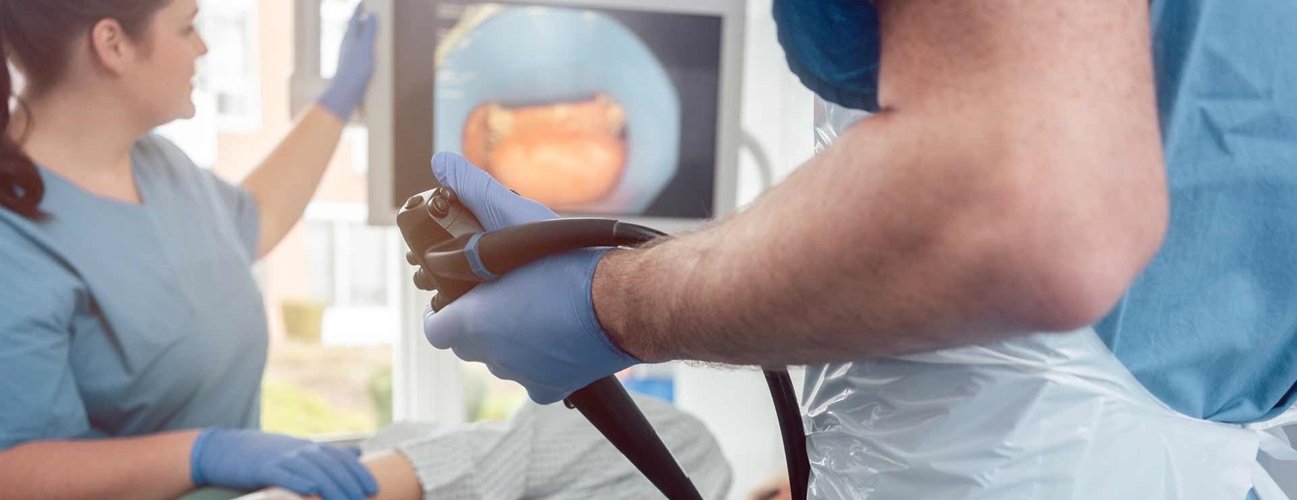G-POEM for Gastroparesis
Gastric peroral endoscopic myotomy (G-POEM) is a procedure to help treat people with persistent gastroparesis.
What You Need to Know
- G-POEM was developed at Johns Hopkins by gastroenterologist Mouen Khashab, M.D., to treat gastroparesis.
- During G-POEM, the ring of muscle controlling the flow of stomach contents to the small intestine is loosened to allow the food to freely pass through.
- G-POEM is an endoscopic procedure, which means it doesn’t require cutting through the skin.
- Data shows that over 70% of people who had G-POEM report that their gastroparesis symptoms lessened or went away.
What is G-POEM?
Gastric peroral endoscopic myotomy (G-POEM) is a minimally invasive procedure to relieve symptoms of gastroparesis. In patients with this condition, the valve between the stomach and small intestine (pyloric sphincter) is unusually tight, preventing the stomach contents from emptying fully into the intestine.
During the G-POEM procedure, an endoscope (a narrow tube with a camera) is inserted through the mouth (peroral) to cut the muscles near the pyloric sphincter (a myotomy). This helps permanently relax the sphincter, so food can empty freely. G-POEM is a less invasive alternative to pyloroplasty — a surgery to widen the pyloric sphincter.
G-POEM works similar to the original POEM procedure performed on the valve between the esophagus and stomach to treat achalasia and related conditions. The success of POEM for achalasia, which is also caused by a valve malfunction, led gastroenterologist Mouen Khashab at Johns Hopkins to become the first person to modify the POEM procedure to treat gastroparesis.
Who may need G-POEM?
A gastroenterologist might suggest G-POEM after you have tried other gastroparesis treatments, such as medications that help empty your stomach. G-POEM can be an effective treatment for persistent gastroparesis that causes severe symptoms.
In early studies of the procedure, G-POEM was found to help people who have had a stent placed in the pyloric sphincter to keep it open. Because stents often move, they are not a permanent solution, but G-POEM provides long-term relief from gastroparesis.
G-POEM Procedure for Gastroparesis | Danielle's Story
Preparing for G-POEM
Your doctor will provide specific instructions to follow before the G-POEM procedure. They may include following a liquid diet for a couple of days and avoiding any food or drink.
Make sure your doctor knows about all of your allergies, medications and supplements. If the medications interfere with the procedure, your doctor will advise whether you need to pause taking them.
Arrange for a responsible adult to take you home after the procedure, since you might be drowsy from anesthesia.
What happens during G-POEM?
- An IV is inserted into a vein to give you fluids, anesthesia and antibiotics. A breathing tube is placed into your trachea to help you breathe while you are under general anesthesia.
- Once you are asleep, the doctor passes the endoscope through the mouth and into the stomach, and looks at images of the inside of the stomach on a monitor.
- The doctor inserts instruments through the endoscope to make a small cut in the lining of the lower stomach near the entrance to the small intestine. A liquid solution is injected into this opening and the endoscope works its way through to separate the lining from the muscle.
- When the endoscope reaches the pylorus — the opening between the stomach and the duodenum — the doctor cuts the surrounding muscles to relax the pyloric sphincter.
- The doctor closes the incision in the stomach lining with small clips or sutures and withdraws the endoscope.
Recovery After G-POEM
When the procedure is finished, you will recover from the anesthesia in the recovery room. When you are awake, the doctor will discuss the results with you. Some patients may need to spend a night or two in the hospital after G-POEM for observation. Your doctor will tell you when you can go home and when to resume your regular diet.
You may need to return for testing and follow-ups to evaluate how well the G-POEM procedure worked. The doctor will perform a gastric emptying test — you will eat food with an isotope that will show up on an X-ray to see how fast the food passes to the small intestine.
In addition to the gastric emptying test, your doctor might use endoscopy (inserting an endoscope into the stomach through the mouth) to check how the tissues are healing.
G-POEM Risks and Complications
The following side effect, most of which are minor and temporary, are possible after G-POEM:
- Abdominal pain
- Sore throat
- Infection
- Ulcers near the pylorus
- Tears in the stomach lining
- Bleeding
- An air bubble in the peritoneal cavity (pneumoperitoneum) or between the lungs (pneumomediastinum)






